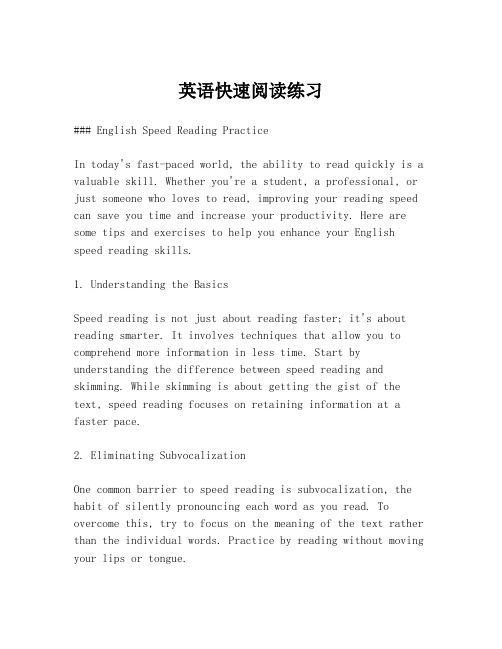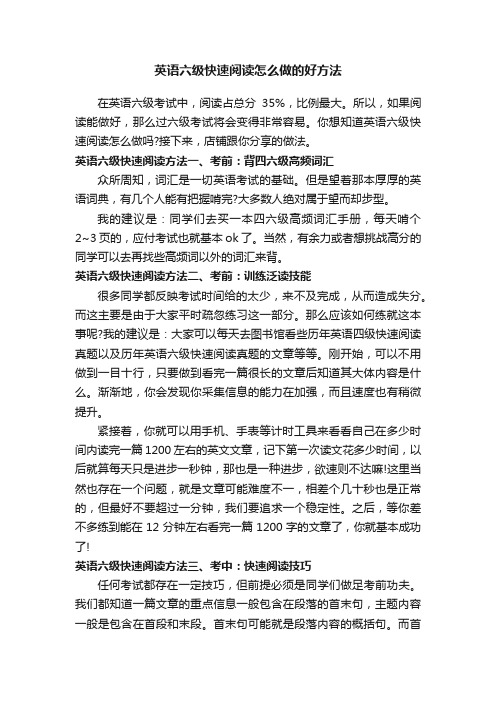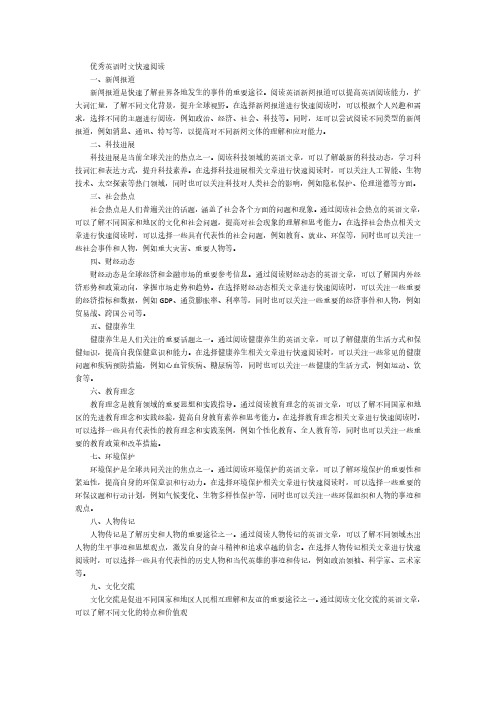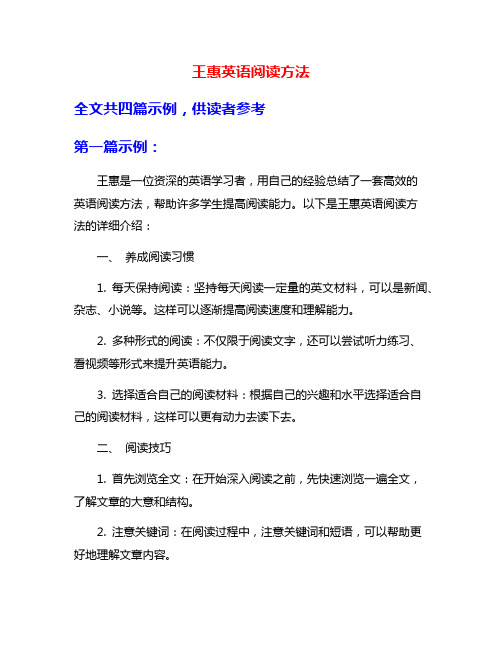英语快速阅读方法示例
英语快速阅读练习

英语快速阅读练习### English Speed Reading PracticeIn today's fast-paced world, the ability to read quickly is a valuable skill. Whether you're a student, a professional, or just someone who loves to read, improving your reading speed can save you time and increase your productivity. Here are some tips and exercises to help you enhance your English speed reading skills.1. Understanding the BasicsSpeed reading is not just about reading faster; it's about reading smarter. It involves techniques that allow you to comprehend more information in less time. Start by understanding the difference between speed reading and skimming. While skimming is about getting the gist of the text, speed reading focuses on retaining information at a faster pace.2. Eliminating SubvocalizationOne common barrier to speed reading is subvocalization, the habit of silently pronouncing each word as you read. To overcome this, try to focus on the meaning of the text rather than the individual words. Practice by reading without moving your lips or tongue.3. Expanding Your Peripheral VisionYour peripheral vision is the area outside your central focus. By training your eyes to take in more information at once,you can read more words per glance. Practice this by using a pen or your finger to guide your eyes across the page, gradually increasing the number of words you take in witheach pass.4. Using a Pacing ToolA pacing tool, such as a pen or a ruler, can help youmaintain a steady reading speed. Move the tool across thetext at a speed that is slightly faster than your current reading pace. This will encourage you to read faster without losing comprehension.5. Chunking InformationInstead of reading word by word, try to read in chunks or groups of words. This can help you process information more efficiently. Start by reading two or three words at a timeand gradually increase the number of words in each chunk as you become more comfortable.6. Reading with PurposeBefore you start reading, ask yourself what you want to getout of the text. Having a clear purpose can help you focus on the relevant information and ignore the rest, which can significantly speed up your reading.7. Practice RegularlyLike any skill, speed reading improves with practice. Set aside time each day to practice your speed reading. Start with texts that are easy for you and gradually move on to more challenging material.8. Monitor Your ProgressKeep track of your reading speed and comprehension. Use a timer to measure how long it takes you to read a set amount of text and then quiz yourself on the content to check your understanding. Over time, you should see improvements in both speed and comprehension.9. Stay HealthyYour physical health can impact your cognitive abilities. Ensure you are well-rested, hydrated, and eating a balanced diet to support optimal brain function.10. Don't Forget to Enjoy the ProcessWhile the goal is to read faster, it's also important to enjoy the reading experience. Don't let the pursuit of speed detract from the pleasure of reading.By incorporating these tips into your reading routine, you can gradually increase your reading speed while maintaining, or even improving, your comprehension. Remember, the key toeffective speed reading is practice and patience. Happy reading!。
英语快速阅读

英语快速阅读英语快速阅读英语快速阅读 1Like most people, I was brought up to look upon life as a process ofgetting. It was not until in my late thirties that I made this importantdiscovery: giving-away makes life so much more exciting. You need not worry ifyou lack money. This is how I experimented with giving-away. If an idea forimproving the window display of a neighborhood store flashes to me, I step inand make the suggestion to the storekeeper. One discovery I made aboutgiving-away is that it is almost impossible to give away anything in this worldwithout getting something back, though the return often comes in an unexpectedform. One Sunday morning the local post office delivered an important specialdelivery letter to my home, though it was addressed to me at my office. I wrotethe postmaster a note of appreciation. More than a year later I needed apost-office box for a new business I was starting. I was told at the window thatthere were no boxes left, and that my name would have to go on a long waitinglist. As I was about to leave, the postmaster appeared in the doorway. He hadoverheard our conversation. “Wasn’t it you that wrote us that letter a year agoabout delivering a special delivery to your home?” I said yes. “Well, youcertainly are going to have a box in this post office if we have to make one foryou. You don’t know what a letter like that means to us. We usually get nothingbut complaints.”像大多数人,我长大看待生命是一个过程获得。
英语六级快速阅读怎么做的好方法

英语六级快速阅读怎么做的好方法在英语六级考试中,阅读占总分35%,比例最大。
所以,如果阅读能做好,那么过六级考试将会变得非常容易。
你想知道英语六级快速阅读怎么做吗?接下来,店铺跟你分享的做法。
英语六级快速阅读方法一、考前:背四六级高频词汇众所周知,词汇是一切英语考试的基础。
但是望着那本厚厚的英语词典,有几个人能有把握啃完?大多数人绝对属于望而却步型。
我的建议是:同学们去买一本四六级高频词汇手册,每天啃个2~3页的,应付考试也就基本ok了。
当然,有余力或者想挑战高分的同学可以去再找些高频词以外的词汇来背。
英语六级快速阅读方法二、考前:训练泛读技能很多同学都反映考试时间给的太少,来不及完成,从而造成失分。
而这主要是由于大家平时疏忽练习这一部分。
那么应该如何练就这本事呢?我的建议是:大家可以每天去图书馆看些历年英语四级快速阅读真题以及历年英语六级快速阅读真题的文章等等。
刚开始,可以不用做到一目十行,只要做到看完一篇很长的文章后知道其大体内容是什么。
渐渐地,你会发现你采集信息的能力在加强,而且速度也有稍微提升。
紧接着,你就可以用手机、手表等计时工具来看看自己在多少时间内读完一篇1200左右的英文文章,记下第一次读文花多少时间,以后就算每天只是进步一秒钟,那也是一种进步,欲速则不达嘛!这里当然也存在一个问题,就是文章可能难度不一,相差个几十秒也是正常的,但最好不要超过一分钟,我们要追求一个稳定性。
之后,等你差不多练到能在12分钟左右看完一篇1200字的文章了,你就基本成功了!英语六级快速阅读方法三、考中:快速阅读技巧任何考试都存在一定技巧,但前提必须是同学们做足考前功夫。
我们都知道一篇文章的重点信息一般包含在段落的首末句,主题内容一般是包含在首段和末段。
首末句可能就是段落内容的概括句。
而首段和末段则是整篇文章的导语和总结。
所以看文章时,着重看一下首末段和首末句。
还有一个技巧适合那些善于抓取信息点的同学,即先浏览题干,再去针对性地看原文,从中定位答案,这样做有时候可以省一些时间。
英语阅读方法与技巧—查读法

同学,我们又见面了。 你知道Scanning是什么阅读方法吗?
Scanning
查读
这种快速阅读方法叫查读,主要是快读一种材料,从 中尽快找到某种资料。如看地图从中找出某个城市在哪里; 看饭店食谱找到自己喜欢的菜;查列车时刻表,找到自己 要乘的火车的时刻;查词典,找出某个词的用法等等。
问题
这类速读要解决两个问题: 问题一:
什么时候可查到所需资料。如,你要查荷兰天文学家Oort的生卒年月,你可以去 查英语人名词典,甚至部分较详细的英语辞典,当然名人辞典(Who’s who) 也许更好;查某个电话号码,要翻阅必备的黄皮书(The Yellow Pages);
问题二:
找到有关的资料来源,要查阅有时也可找窍门,如你的资料来源是一份报纸,你 要在里面找到广告的话得先找到“分类广告索引”。
查读法
查读法尤其适合于广告类题目,因为广告类题目大部分的 情况下都是信息对比题
查读法过程(scanning):先看题目,找出定位词,文章里找相关信息,进行对 比。(换句话说,我们没有必要把一则广告从头到尾地、逐字逐句地阅读,只要找 准定位词,快速地在文章内“扫描”出定位词,问题也就迎刃而解。) 适合这种方法的有:1.广告题材中的信息对比题
如何做笔记: (1) 先读一节,然后有选择地标记和下划线; (2) 用圆圈或方框标注特殊词汇和过渡词; (3) 在页边空白处用数字列出重要的或连续的想法; (4) 在重要信息下面划线,就好像你在抄以前学习的简要笔记一样; (5) 在所有定义、术语、规则、标准、测试和例外下划线; (6) 标记/标注代表主要观点的示例; (7) 在课文中的空白处草草记下释义、问题和摘要。
查读法
Scanning--to glance from point to point of often hastily, casually, or in search of a particular item.
英语快速阅读的6个技巧与7个方法介绍简短

英语快速阅读的6个技巧与7个方法介绍简短英语快速阅读不是一种孤立的能力,它必须以了解一定的基本知识为先决条件,以具备一定的词汇和基本语法为基础。
下面就是小编给大家带来的英语快速阅读的6个技巧与7个方法,希望大家喜欢!英语快速阅读的6个技巧英语快速阅读的技巧1. 推测(prediction)阅读正文前,就标题(如果有标题的话)来合理推测资料的大概内容,也可在读了二、三段之后预测下段内容。
这对快速理解和整体把握文章内容以及推测出生词的词义范围有积极的意义。
因为英语单词一词多义现象太普遍了,一个单词在不同的专业领域往往含有不同的意思,甚至有的单词在同一专业领域在其意义的具体把握上也有细微的差别。
英语快速阅读的技巧 2. 关键词句(key•word•and topic•sentences)。
在对文章的整体内容有了基本认识的基础上,我们学会抓主要的词句,找出段落中的主题句,从而正确领会文章的主要内容,并注意到是否对自己有利用价值。
英语快速阅读的技巧3. 略读或浏览或跳读(Skimming)Skim有掠过的意思,又有从牛奶等液体上撇去的意思,转意为“快速掠过,从中提取最容易取得的精华”。
用于阅读,或译为略读,或译为泛读,似乎都未把其细微的意思译出。
而这种读法却包含有原词的所有意思——快速读过去,取出读物中关键性的东西。
因此,我们可以把这种读法理解为快速浏览课文,领会文章大意。
一般而言,通过标题可知道文章的主题。
对文章的首段和末段要多加注意,以便发现作者的观点。
英语快速阅读的技巧4. 查阅(Scanning)Scaning的意思是扫读或查阅,是快读或速读的一种。
Scan就是通常所说的“扫描”。
其特点是快,但又要全部扫及。
Scan这个词的词义似乎矛盾,它既可以理解为“仔细地审视”,也可以理解为“粗略地浏览”。
这种情况倒成了扫读的绝好证明。
从形式上看,扫读是粗粗地一扫而过,一目十行,但从读者的注意方面来看,却又是高度的集中,在快速阅读中仔细挑出重要的信息。
英语四级快速阅读技巧优秀5篇

英语四级快速阅读技巧优秀5篇快速阅读,是英语四级考试当中,会遇到的一种题型,那么怎么才能够做好呢?下面是书包范文为您精心整编的英语四级快速阅读技巧优秀5篇,希望能够对大家的写作有一点启发。
两大基本考点,skimming和scanningSkimming,略读略读,顾名思义就是要求考生在较短时间内把握住文章一些段落的主题思想。
Scanning,跳读跳读其实对大家来说就比较熟悉了。
首先是找准题干关键词,然后带入原文定位寻找答案。
段落中与关键词无关部分可以一概略去不看。
每次快速阅读考试都有几个直接定关键词就能得答案的送分题。
建议考生可以按照“三步走”的思路来进行解题:1、浏览大标题和小标题(了解文章主题结构)2、精读文章的开头(准确把握文章的主题)3、看一题做一题,关键词定位配合顺序原则附例题:Like a needle climbing up a bathroom scale, the number keeps rising. In 1991, 15% of Americans were obese(肥胖的); by 1999, that proportion had grown to 27%。
Youngsters, who should have age and activity on their side, are growing larger as well: 19%of Americans under 17 are obese. Waistbands have been popping in other western countries too, as physical activity has declined and diets have expanded. By and large, people in the rich world seem to have lost the fight against flab(松弛)。
大学英语六级考试快速阅读训练(1篇)

大学英语六级考试快速阅读训练(1篇)大学英语六级考试快速阅读训练 1一、快速阅读简介大学英语六级考试中的快速阅读题型是大学英语六级考试__后,在2007年6月首次出现的一个题型。
它要求考试者在15分钟之内阅读一篇英语文章,大约为1200词左右,回答10个问题,并且填涂答题卡的时间也包括在这15分钟之内。
通过对07年6月到09年12月的六份大学英语六级考试真题进行分析,快速阅读的内容比较杂,如07年6月是“Seven Steps to a More Fulfilling Job”,07年12月是“Seven Ways to Save the World”,08年6月为“What will the world be like in fifty years?”,08年12月是“Supersize Surprise”,09年6月是“Helicopter Moms vs.Free-Range Kids”,09年12月是“Bosses Say ‘Yes’ to Home Work”。
阅读后,要了解文章的大意,并能找出所需细节。
六份试题中有三份的第一个问题就是有关文章大意的,如08年6月第一个问题是“What is John Ingham’s report about?”,08年12月的第一问题是“What is the passage mainly about?”,09年12月的第一个问题又是“What is the main topic of this passage?”。
二、快速阅读的训练在快速阅读过程中要突出“快速”二字,这是区别于普通阅读的关键。
在阅读过程中,要一目十行,不能纠缠于文章中的某一细节,如果有的内容看不懂,先不用管它,要一直往下读,要以掌握文章的主要内容和中心思想为主,这样才能达到快速阅读的目的。
如果这一难懂的内容是自己确实要弄懂的问题,那么看完文章后,可以返回到这一段再仔细阅读。
在六级考试中,如是后面的问题与这一内容有关,再认真阅读也不迟。
英文快速阅读方法(全英文)

Speed-Reading TechniquesI was a Bible college student when one of our chapels featured a guest speaker who taught us how to speed-read. At the time I didn’t need the skill since most collateral reading assignments in my courses were under 500 pages, but I started practicing just for the fun of it– sort of like a private parlor game. However all that changed when I wound up in graduate school at Princeton Seminary and several Profs. expected me to read several thousand pages of collateral alongwith the fi ve or six textbooks. That’s when I got serious about speed reading. Here is the collection of what I practiced then, and picked up since. The first thing I had to do was toss away the reading myths I had held so long.Reading Myths1. Reading is linear. I had always figured reading wasa linear process; you know, start up front and grind through to thevery end in the exact order it was printed in. Reading is no morelinear than thinking is, (or I eventually discovered, than writing; few writers start at the beginning —indeed, they usually ―write the first part last.‖2. True reading is word-for-word. I started as a kidlooking at individual letters. They didn’t help much. Next I started sounding out syllables. Finally, I could read whole words. Why stopw ith words? Well, I know one reason… I had a college professor who madeus swear we had ―Read every single word‖ of our collateral reading. Why? He didn’t make us swear we’d ―read every single letter.‖ The answer is simple: that professor (like me) had never moved from letters, syllables, and words, to reading phrases, sentences and paragraphs. He assumed the only way to read thoroughly was by the laborious method of reading one word at a time.3. Reading is a laborious task which takes a long time. Not at all! Reading can be both fun and fast. Indeed, speed reading is like auto racing — it is far more exciting.4. All parts of a book are of equal value. This mythpersists until you actually write your own book. Then, all at once you realize there is ―filler‖ material , illustrations, and even sometimes whole chapters jammed into a book just because the publisher insisted. Take messages for instance. Ever hear a message and wish you could putit on fast forward over that long story illustrating a point youalready understand? Well, in reading you can fast forward.5. Reading faster will reduce retention. Sorry. Itshould be that way, shouldn’t it? Those who groan slowly through a bookpainstakingly sounding out every single word, maybe even moving theirlips, should get a greater reward shouldn’t they? Sorry. In fact, speed reading techniques will increase one’s comprehension and retention.Getting Ready to ReadSo, we’re ready to read. But don’t read the book yet. There are a few steps to take first.FIRST: ELIMINA TE ALL DISTRACTIONS: Get rid of ANYthingyour mind could think about besides the reading material. Is there conversation? Activity? TV? An uncomfortable seat? Music in the background? (OK OK, I know many of my readers are college students whoclaim th ey ―study better‖ with music in the background. Go ahead and claim it —but you are wrong. Y ou might ―like it‖ better, but you donot study better. ANYthing which might occupy your mind waters downyour concentration —even occupying your ―mind-in-backgrou nd.‖ Foolyourself if you wish — but if you really are serious about reading faster, eliminate distractions.SECOND: Ask: What is my purpose? Why are you readingthis? And what kind of literature is it? Is it a classic or fictionwork you are reading for fun? Then, why hurry through it at all? Like a leisurely meal, sit back and taste each bite — turn over the delicious phrases in your mind. Or is collateral reading for a course where you are must be familiar with the central notions? Then finding the notions is why you are reading, right? Or maybe you are reading collateralwhere you will be tested on the content? Or maybe collateral reading where you will be required to say, ―I read every single word?‖ Or isthis a book where you will be tested on the terms and dates therein? Or, maybe you are just reading the book searching for some new ideas for your own situation. Or you have to write a review. Or maybe you plan to teach it to others. See how different your purpose might be for each? Before you open the book, take a minute to state your purpose to yourself. It will largely determine how you read the book from then on.THIRD: Do a 10 minute PRE-READ. Take ten minutes orless and pre-read the entire book. Go ahead and try this if you’venever done it before. Treat a book like a jigsaw puzzle. Dump it out, then organize all the pieces first before putting it together. Read the dust cover and any cover reviews. Then look through the author blurb. Move to the Table of Contents and see if you can figure out the whole book from this page. Page through the entire book, page by page and glance through all summaries, tables, pull-out quotes,diagrams(especially), and scan through all the section titles and you go.Chances are you’ll find the KEY CHAPTER while you are doing this. Some publishers say (off the record, of course) ―A book is simply one great chapter with a dozen other filler chapters.‖ If this is so, find that chapter.FOURTH: Read the KEY CHAPTER. Start using the rapid reading techniques mentioned later to read this KEY CHAPTERthrough.Y ou are not obligated to wait until you have read all the chapters before this one, as if you must eat your green beans before the ice cream. The book is yours — go ahead and get the central idea before you start!Once you’ve read the key chapter you are ready to read the rest. In order from the front to the back, or in some other order which better suits your purpose. Now for some actual reading tips tips.III. Rapid Reading Techniques1. Raise your speed- comfort level. How comfortableare you speeding in a car? How fast do you have to go before you feel you are ―on the edge?‖ 70 MPH? 90? 120? How about 210 MPH, the speedthe Indy car drivers can average? Get the point? Some people have learned to drive faster; their comfort level has been raised. Y ou cando the same thing for reading. Face it, speed-reading isn’t mostly about technique; it is about mind set. Indeed this may be the reason you can play a CD while reading — you are merely driving along at25MPH. Can you imagine an Indy car driver playing music in the background? No. The driver focuses all his or her skills on the track.If you are out for a Sunday afternoon stroll in your book, then ignore this. But if you are serious about becoming a speed-reader, then start expecting more of yourself.2. See the book as a mine full of ORE not GOLD. Booksoffer wonderful gold to the prospector. But the reader must sort through tons of ore to find and refine the gold. The speed reader changes mindsets: quits fooling around with the ore and searches for the gold. What is a book anyway? What are words? They are ―carriers‖ oftruth, thoughts, ideas, a thesis, information, terms, concepts, notions. One reads a book to get the message, not to obsess on the words. (I’m tempted here to talk about Bible study, but we shall let it pass this time.) Switch your mindset to looking for the gold.3. Quit Subvocalizing. Most of us learned to read bysounding out the words. The trouble is, most of us never stopped. Sure, maybe we no longer audibly sound them out, or even move our lips, but in our heads we are ―reading to ourselves.‖ We have learned to read by Mouth-and-Ear. To become a speed reader one must discard this habit (orat least reduce it) and adopt the eye-and-mind method. It is mostly a matter of mind set. Instead of acting like the ear (even in one inside your head) is the route to the mind, begin believing that the eye isthe gate to the mind. Start drinking in books through your eyes. Letthe books pass into the mind directly from the eye, skipping the mouth and ears. Go ahead and start trying it.4. Use your finger. For most beginning speed-readersthis is a shock. They remember reading in grade school with their finger and assume it slows one down. Actually the finger is your pacecar. It leads you forward at a speedy pace, and keeps you on focus and avoiding back-skipping. There are several ways to use your finger (or hand) but just try it out for starters. As you improve, buy one of the books on speed-reading and settle on the pattern which works best for you.5. Break the Back-skip habit. Most of us read along aline of type like this one to get the interpretation of the meaning,but as we read our eyes jump back to dwell on a word we just passed. Wedo this without knowing it. In fact, probably the only way to discover how many times you back skip is to have someone watch you read and count the eye-darts back. But, unless you have someone you feel pretty comfortable staring you in the face while you read, just trust me –you probably back-skip. How to stop? First confess you do it. Then start recognizing when you do it. Finally when tempted to back-skip, treat the book like a movie — that is, even if you miss something in a movie, you don’t stop the video and replay it. Y ou just le t it flow on through, hoping you’ll make it up later.6. Use your peripheral vision. Just like you must develop a muscle in the gym, so your mind can be trained to use the eye-gate to take in a broader amount of data. For instance, instead of reading leftto right across the lines, pretend there is a line right down themiddle of this page and you are following the line. Let your eye takein through peripheral vision the phrases to the right or left. Can youdo it? With practice you can train your mind to r ead on ―both sides of the road‖ even though your eyes are on the center line. To practicethis skill most speed readers actually draw lines down pages of a book until they have mastered the skill with an invisible line. Let your mind drink in the information on the page without looking directly at it —just like you ―see‖ the sides of the road when driving an automobile.7. Learn to read KEY WORDS. 40-60% of the words on apage are neither critical nor important. Indeed, if someone tookwhite-out and hid them from your sight, you could still figure out what the paragraph was communicating. So, it stands to reason that if you could figure out which are these KEY WORDS you could scan past the other words and let your mind fill in the blank. Train your mind to find these key words and you’ll add even more speed to your reading.8. Eliminate ―Bus Stops‖ (Eye rests). As your eyesread down this line they stop periodically and ―rest‖ on a word. Children’s eyes often rest on every single word as they learn to read. Then as you grow your eyes move smoothly down the line like a lawn mower, then you stop a split second on a word, then start back up again. Most reader never get over this habit, but like a bus stoppingat every corner, it slows down your progress. Try to reduce your eye rests to 3-4 per line, maybe even less as you get better… keep the eye moving smoothly line after line, letting your mind drink in the knowledge on the line.9. Take breaks. The research is clear. Steady readinghour after hour is less efficient than taking a five minute break every hour or less. Sit down to read 100 pages in the next hour. Set an alarm even. Then reward yourself with a cookie or sandwich when you’ve reached your goal in 60 minutes.10. Set a time goal. Have a 300 page book to read?Decide how fast you’ll read it. If you are not a speedy reader, maybe you’ll only set the US average reading speed as your goal: one page a minute (250 words/min.). Or if you are already an above average reader, set 100 pages an hour and plunge in. If you picked 100 pages an hour, that’s 50 in a half hour, 17 per 10 minutes or 1.7 pages per minute. Keep on track… pretend like you are in an auto race… push yourself, concentrate, get yourself out there on the ―racer’s edge‖ — the linejust short of out-of-control, yet still in command. Do it; it will be exciting!IV Retention Techniques1. Underline, circle, make margin notes. Nothighlighting the whole page like some students do! Usually you will not mark more than two or three items per page, and many pages will have nomarkings. Marking pages increases recall — do you have a marked-up Bible? If you do, you can almost ―see‖ the page in your head when recalling it. Marking helps. (Highlighting may help — your own markings, however, are probably superior).2. Dog-ear important pages. In a 250 page book therewill probably be 25 pages worth dog-earing. Turn down the page to return later. The bigger the dog-ear the more important the page. Most books have only four or five half-page-dog ears.3. Transfer key notes to front of book. Got a greatpoint here? The central message? The quote which essentially representsthe whole book? Write it down in the front of the book. Why? Generally speaking when it comes to new information you either ―Use it or lose it in 20 minutes.‖ When you discover it, flip the book open to the front and scribble it down; it will cement the notion into your mind. Better yet, link it to something you already know and write that down too. Linked information can be recalled far better than isolated information.4. When finished, re-read dog-eared pages. Just run back through and re-read the gold. Here is the essence of the book (if you made judgements right going through).5. Now write an ―abstract‖ in the back or front. Y ou arefinishe d! Go for a pizza… but not just yet. Take a few more minutes andwrite an ―abstract‖ up front in your own words. When the writer submitted the proposal for this book, he or she probably actually had a single paragraph or page, outlining what this book was all about. To summarize the book, simply ―reverse engineer‖ the book back to the author’s abstract or thesis.6. Consider drawing a ―MindMap‖ of the contents. Ifyou are going to be tested on this book, get someone to teach you how to use Tony Buzan’s ―Mind Map‖ to remember the entire book on a singlepage. Remember, the mind mostly recalls ideas and pictures, not words.A Mind Map will enable you to ―picture‖ the whole book and you’ll looklike you posses a ―photographic‖ (which you really don’t need, if y ou simply follow the advice in this article).7. But if you borrowed the book, and can’t mark it,dog-ear it, or otherwise ―use‖ this took — then use 3M stickers instead of dog-ears, and write your comments on half-sheets of paper as you go.Finally,remember this: speed-reading is not some magical secret you can pick upin ten minutes and Presto! Y ou now can read 1000 words per minute. True, you can learn to read faster; perhaps double your presentspeed in two weeks. But to become a life-long rapid reader (like becoming a proficient race car driver) takes time, concentration and practice. This short article can get you started, but to really become expert you’ll need to practice plenty.To help you develop this skill further try one of the many books on rapid reading. (Y ou only need one to start with, most all articles (likethis one) books and courses basically cover similar techniques.)。
快速读英语的方法

快速读英语的方法
以下是一些快速读英语的方法:
1. 重复阅读:重复阅读可以帮助提高阅读速度和理解能力。
你可以在同一篇文章或单词卡片上反复阅读,以加深对它们的理解。
2. 快速阅读前预热:在开始快速阅读之前,预热一下可以帮助你更好地适应阅读速度。
你可以先进行一些快速阅读的练习,例如通过做阅读理解或听英语材料来提高阅读速度和反应能力。
3. 集中注意力:在阅读时,集中注意力是非常重要的。
你可以选择一个安静、不会被打扰的地方阅读,并且关闭手机、电脑等干扰因素。
4. 使用速读软件:速读软件可以帮助你提高阅读速度和效率。
这些软件会逐字或逐行展示文章,并设置阅读时间限制,帮助你在较短的时间内完成阅读。
5. 扩大词汇量:扩大词汇量是快速阅读的关键。
你可以通过阅读英文单词卡片、听英语新闻、看英文电影等方式来扩大词汇量。
6. 练习听力:听力也是快速阅读的重要方面。
你可以通过听英语新闻、广播、电视节目、英文歌曲等方式提高听力水平,从而更好地理解文章中的内容。
快速阅读需要长期的努力和练习。
通过以上方法,你可以提高阅读速度和效率,更好地掌握英语。
大学英语四级———快速阅读做题技巧PPT课件

你知道吗???
❖ 一 在平时做英语阅读训练的时候,要定好了时 间训练,多练习就会适应快速阅读了,而且还能 找到做题的技巧。
❖ 实现它应有的效果。
4
一、快速阅读的命题规律
❖1. 逻辑关系处常设考点 ❖ 逻辑关系散布在文章的句子中、句句之间以及段
13
注意:
❖一、把没用的信息跳过。想找到有用的信息,
先要知道你要什么信息,才能有的放矢。要记住 尽量少但最有效的问题单词或者句子。要找这样 的单词:原文当中出现而且题目也出现,这样的 单词是重点,文章出现这样单词的前后要着重的 读,很可能大家就在这。
❖ 二、如果你找不到这样的单词,就要看懂问题问 的是什么,然后带着这个问题在读文章的时候要 有目的的读,遇到了就要仔细的读,很可能问题 大家就在那附近。
10
2024/10/14
11
❖ 定位词的本质:特殊性和细节性。 ❖ 文章中多次出现的语汇不是定位词。越细节越特
殊的词,在文章中出现的频率越低,一旦找到, 它旁边的信息应该就是考点了。
12
❖ 意题干中的定语和状语。 ❖ 定语可以使一个概括性的概念更加细节化,状语
可以使一个一般性的动作更加特殊化。所以,如 果题干较长,又没有特殊印刷体文字的情况下, 选取定语和状语中有代表性的词作为定位词,比 较可靠。当然不排除主语和谓语本身就很特殊, 或者考点词本身就是定位词的情况。
2
❖ 因为scanning的过程只是在查找,所以,在这 个时候,所有词汇都蜕变为符号。
❖ 定位词是个符号,原文所有词都是符号。 scanning是个符号对应的过程。眼睛如探照灯, 同时扫过好几行——找符号。
❖ 纠正scanning的错误,就是纠正在查读过程中, 总是想词汇意思的习惯。
优秀英语时文快速阅读pdf

优秀英语时文快速阅读一、新闻报道新闻报道是快速了解世界各地发生的事件的重要途径。
阅读英语新闻报道可以提高英语阅读能力,扩大词汇量,了解不同文化背景,提升全球视野。
在选择新闻报道进行快速阅读时,可以根据个人兴趣和需求,选择不同的主题进行阅读,例如政治、经济、社会、科技等。
同时,还可以尝试阅读不同类型的新闻报道,例如消息、通讯、特写等,以提高对不同新闻文体的理解和应对能力。
二、科技进展科技进展是当前全球关注的热点之一。
阅读科技领域的英语文章,可以了解最新的科技动态,学习科技词汇和表达方式,提升科技素养。
在选择科技进展相关文章进行快速阅读时,可以关注人工智能、生物技术、太空探索等热门领域,同时也可以关注科技对人类社会的影响,例如隐私保护、伦理道德等方面。
三、社会热点社会热点是人们普遍关注的话题,涵盖了社会各个方面的问题和现象。
通过阅读社会热点的英语文章,可以了解不同国家和地区的文化和社会问题,提高对社会现象的理解和思考能力。
在选择社会热点相关文章进行快速阅读时,可以选择一些具有代表性的社会问题,例如教育、就业、环保等,同时也可以关注一些社会事件和人物,例如重大灾害、重要人物等。
四、财经动态财经动态是全球经济和金融市场的重要参考信息。
通过阅读财经动态的英语文章,可以了解国内外经济形势和政策动向,掌握市场走势和趋势。
在选择财经动态相关文章进行快速阅读时,可以关注一些重要的经济指标和数据,例如GDP、通货膨胀率、利率等,同时也可以关注一些重要的经济事件和人物,例如贸易战、跨国公司等。
五、健康养生健康养生是人们关注的重要话题之一。
通过阅读健康养生的英语文章,可以了解健康的生活方式和保健知识,提高自我保健意识和能力。
在选择健康养生相关文章进行快速阅读时,可以关注一些常见的健康问题和疾病预防措施,例如心血管疾病、糖尿病等,同时也可以关注一些健康的生活方式,例如运动、饮食等。
六、教育理念教育理念是教育领域的重要思想和实践指导。
英语快速阅读方法8篇

英语快速阅读⽅法8篇英语快速阅读⽅法1 在英语考试中,很多考⽣会因为阅读速度跟不上影响做题,以⾄于最后影响到成绩,因为阅读部分占据分数中蛮⾼的⽐例。
为帮助⼤家解决这个问题,接下来将为⼤家详解英语备考练习快速阅读的⽅法是什么,希望这些对⼤家有所帮助。
在阅读英语材料时或是在考试过程中有很多⼈感到⾃⼰的阅读速度实在是跟不上需要,有些朋友就认为是⾃⼰的英语基础不⾏,然后就拼命的背单词,其实如果能够⽤正确的⽅法进⾏快速阅读训练的话,即使在原有的基础上也可以在阅读速度⽅⾯取得显著的提⾼,更何况很多情况下根本就不是英语基础的问题。
现在就让我们来看看练习快速阅读的四种⽅法。
1、快速泛读(fast extensive reading)平时要养成快速泛读的习惯。
这⾥讲的泛读是指⼴泛阅读⼤量涉及不同领域的书籍,要求读得快,理解和掌握书中的主要内容就可以了。
要确定⼀个明确的读书定额,定额要结合⾃⼰的实际,切实可⾏,可多可少。
例如每天读20页,⼀个学期以18周计算,就可以读21本中等厚度的书(每本书约120页)。
2、计时阅读 (timed reading) 课余要养成计时阅读的习惯。
计时阅读每次进⾏5~10分钟即可,不宜太长。
因为计时快速阅读,精⼒⾼度集中,时间⼀长,容易疲劳、精⼒分散,反⽽乏味。
阅读时先记下“起读时间”(starting time),阅读完毕,记下“⽌读时间”(finishing time),即可计算出本次阅读速度。
随⼿记下,长期坚持,必定收到明显效果。
3、略读 (skimming) 略读⼜称跳读(reading and skipping)或浏览(glancing),是⼀种专门的,⾮常实⽤的快速阅读技能。
所谓略读,是指以尽可能快的速度阅读,如同从飞机上鸟瞰(bird's eye view )地⾯上的明显标志⼀样,迅速获取⽂章⼤意或中⼼思想。
换句话说,略读是要求读者有选择地进⾏阅读,可跳过某些细节,以求抓住⽂章的⼤概,从⽽加快阅读速度。
王惠英语阅读方法

王惠英语阅读方法全文共四篇示例,供读者参考第一篇示例:王惠是一位资深的英语学习者,用自己的经验总结了一套高效的英语阅读方法,帮助许多学生提高阅读能力。
以下是王惠英语阅读方法的详细介绍:一、养成阅读习惯1. 每天保持阅读:坚持每天阅读一定量的英文材料,可以是新闻、杂志、小说等。
这样可以逐渐提高阅读速度和理解能力。
2. 多种形式的阅读:不仅限于阅读文字,还可以尝试听力练习、看视频等形式来提升英语能力。
3. 选择适合自己的阅读材料:根据自己的兴趣和水平选择适合自己的阅读材料,这样可以更有动力去读下去。
二、阅读技巧1. 首先浏览全文:在开始深入阅读之前,先快速浏览一遍全文,了解文章的大意和结构。
2. 注意关键词:在阅读过程中,注意关键词和短语,可以帮助更好地理解文章内容。
3. 不懂的地方标记:遇到不懂的单词或句子可以标记下来,之后可以查字典或者翻译来理解。
4. 刻意练习:不断练习阅读,可以选择一些难度适中的文章来进行刻意练习,提高阅读水平。
三、阅读策略1. 阅读之前设定目标:在开始阅读之前设定一个阅读目标,比如提高阅读速度、理解文章主旨等。
2. 主动提问:在阅读过程中,可以自问一些问题来帮助理解文章,比如文章在谈论什么主题、作者的观点是什么等。
3. 反复阅读:阅读一篇文章时可以进行多次阅读,这样可以更深入地理解文章内容。
四、善用工具1. 使用字典:遇到不懂的单词可以查字典来了解含义,也可以学习单词的拼写和发音。
2. 利用互联网资源:可以利用互联网资源如在线词典、翻译工具等来帮助理解文章。
3. 结合听力练习:阅读的同时可以听相关的录音或视频,这样可以提高听力水平。
以上就是王惠英语阅读方法的详细介绍,希望对大家在英语阅读方面有所帮助。
记住,阅读是提高英语能力的重要途径,不断练习和积累经验将会帮助你取得更好的成绩。
第二篇示例:王惠是一位英语学习达人,她通过自己的实践和总结总结出来了一套高效的英语阅读方法。
下面就让我们一起来看看王惠的英语阅读方法是怎样的吧!一、培养阅读兴趣王惠认为,阅读英语文章首先要培养阅读的兴趣。
如何提高英语阅读速度的好方法

如何提高英语阅读速度的好方法提高英语阅读速度的方法有很多,以下是一些建议供您参考:1. 增加词汇量:词汇量是提高阅读速度的基础。
通过阅读不同类型的文章、书籍和杂志,了解和学习更多的词汇。
您可以制定每天学习一定数量的生词的目标,以帮助您更好地理解文章。
2. 学习词根、词缀和词义:了解词根和词缀可以帮助您更快地识别和理解生词,从而提高阅读速度。
例如,通过识别词根“bio-”(表示生命的),您可以更快地理解词汇,如“生物”、“生物学”等。
3. 练习分块阅读:将文章划分为几个部分,而不是逐字阅读。
这样可以让您更快地理解整个句子的意思,而不是停留在每个单词上。
4. 提高扫读和略读技巧:扫读是快速阅读文章以获取其中的主要观点;略读是选择性阅读文本,跳过那些您认为不重要的部分。
在阅读英语文章时,学会扫读和略读有助于提高阅读速度。
5. 定期进行阅读练习:提高阅读速度需要时间和练习。
每天花一定时间进行阅读练习,这样您的阅读速度会逐渐提高。
6. 使用阅读辅助工具:有些阅读辅助工具可以帮助您提高阅读速度,例如电子词典、速读软件等。
这些工具可以帮助您更快地查找生词、了解文章结构等。
7. 学会做笔记和总结:在阅读过程中,学会做简要的笔记和总结,有助于您更好地理解文章内容,从而提高阅读速度。
8. 保持耐心和毅力:提高阅读速度需要时间和努力。
在学习过程中,保持耐心和毅力,不断练习,您的阅读速度会逐渐提高。
总之,提高英语阅读速度需要多方面的努力,包括扩大词汇量、学习词汇技巧、练习阅读策略等。
通过不断练习和积累经验,您的英语阅读速度会逐渐提高。
英语快速阅读的技巧和方法

英语快速阅读的技巧和方法快速阅读是提高阅读效率的一种方法,通过运用一些技巧和方法,可以更好地理解和记忆所读内容。
下面是一些实用的英语快速阅读技巧和方法。
1. 扫视阅读(Scanning):这是一种用来快速查找特定信息的技巧。
在阅读时,不需要阅读每个单词或每个句子,而是将目光快速移动,寻找关键词或关键句子。
这样可以节省时间,快速找到所需信息。
2. 跳读(Skimming):这是一种通过阅读文本的标题、副标题、首段和结尾来获取整体理解的技巧。
通过对文章进行快速浏览,可以抓住主要观点和要点,忽略细节。
这种方法适用于在有限时间内了解文章的大意。
3.改变阅读速度:根据阅读材料的难度和重要性,可以适当调整阅读速度。
对于容易理解的内容,可以加快阅读速度;对于难理解或重要的内容,则需要放慢阅读速度,以确保理解准确。
5.扩大词汇量:拥有丰富的词汇量可以加快阅读速度和理解能力。
通过学习和记忆新的词汇,可以更容易地理解阅读材料,从而提高阅读速度。
7.注意文章结构:了解文章的结构可以帮助更好地理解内容。
扫描标题、副标题和段落之间的连接词和关键词,可以帮助快速理解文章的逻辑关系和主题。
8.利用标记和笔记:使用标记和笔记可以帮助理清思路,提醒关键点,以及回顾和复习内容。
可以使用标记符号来标记关键词、重要观点或需要回顾的内容。
同时,可以在文本旁边或笔记本上做一些简洁的笔记,以便以后回顾。
9.多样化阅读材料:阅读不同类型的材料可以增加阅读的广度和深度。
通过阅读各种材料,如新闻、小说、科学文章等,可以提高对不同主题和风格的理解能力,有助于提高阅读速度和适应不同类型的阅读任务。
10.培养阅读兴趣:对于提高阅读速度和效果,培养阅读兴趣是至关重要的。
选择感兴趣的话题和阅读材料,将阅读当作一种乐趣而不是任务,可以提高阅读的主动性和快乐感,从而改善阅读效果。
总结起来,快速阅读需要一系列技巧和方法相结合。
通过扫视阅读、跳读、改变阅读速度、避免子音阅读、扩大词汇量、练习阅读、注意文章结构、利用标记和笔记、多样化阅读材料以及培养阅读兴趣等,可以提高阅读速度和理解能力,更快地掌握所读内容。
九种快速阅读英语的方法与快速阅读英语的技巧

九种快速阅读英语的方法与快速阅读英语的技巧人的大脑分为左右两部分,各自分管并对不同的信息内容处理:其中右脑主要是对图形和图像进行记忆和加工,而左脑主要是处理诸如规律、数字、文字等非形象化的信息。
下面就是我给大家带来的九种(快速阅读)英语的(方法)与快速阅读英语的技巧,盼望大家喜爱!九种快速阅读英语的方法与快速阅读英语的技巧(一)九种快速阅读英语的方法:Preview the mrial youre going to read. Look at main headings, chapter divisions, and other relevant mrial--to develop clues about the structure of the work。
1、先预览一下你的阅读材料。
留意主标题、章节安排、和其他相关材料,旨在构筑阅读材料的结构布局。
(拓展:)Adjust your reading speed as you read the mrial. Slow down when you need to be sure that you comprehend a section of mrial. Speed up if you are already familiar with (or dont need to know) other sections。
2、在阅读的同时调整阅读速度。
对于需要理解领悟的篇章,放慢速度;而对于已熟知(或不需要知道)的内容,快速读过。
(拓展:)Readers can dramatically improve their reading speeds by taking in several words in the line of text at one time (instead of sounding out each word, or focusing on each letter of the word. Compr programs like Speed Reader or Rapid Reader are designed to help readers improve reading speeds with fhing letters and words. You may also want to learn more about othertechniques。
如何做快速阅读英语作文

如何做快速阅读英语作文How to Read English Articles Quickly。
Reading English articles quickly is a skill that can be very useful in many situations, such as when you need to study for an exam, when you want to stay up-to-date on current events, or when you simply want to improve your English comprehension skills. Here are some tips on how to read English articles quickly and effectively:1. Skim the article first。
Before you start reading the article in detail, take a few minutes to skim through it quickly. Look at the headings, subheadings, and any bold or italicized text to get an idea of what the article is about. This will help you to focus your reading and understand the main points more quickly.2. Read the first and last paragraphs。
The first and last paragraphs of an article often contain the most important information. The first paragraph will usually give you an idea of what the article is about, while the last paragraph will summarize the main points and conclusions. By reading these paragraphs first, you can quickly get a sense of whether the article is relevant to your needs.3. Look for key words and phrases。
- 1、下载文档前请自行甄别文档内容的完整性,平台不提供额外的编辑、内容补充、找答案等附加服务。
- 2、"仅部分预览"的文档,不可在线预览部分如存在完整性等问题,可反馈申请退款(可完整预览的文档不适用该条件!)。
- 3、如文档侵犯您的权益,请联系客服反馈,我们会尽快为您处理(人工客服工作时间:9:00-18:30)。
The primary basis of handwriting analysis as a science is that every person in the world has a unique way of writing. When we were all kids in primary school, we learned to write based on a particular copybook -- a style of writing. Which copybook our handwriting is based on depends on when and where we grew up. So at first, we all probably wrote in a similar way to kids of our own age and location. But with the passing of time, those writing characteristics we learned in school -- our style characteristics -- became only the underlying method of our handwriting. We developed individual characteristics that are unique to us and distinguish our handwriting from someone else's. Most of us don't write the way we did in first or second grade. And while two or more people may share a couple of individual characteristics, the chance of those people sharing 20 or 30 individual characteristics is so unlikely that many handwriting analysts would say it's impossible.
First and foremost, handwriting analysts must be able to accurately distinguish between style characteristics and individual characteristics, which takes a lot of training. They can pretty much ignore the style characteristics, which are only useful for determining with a fair degree of certainty which copybook the writer learned from. The individual characteristics are what matter the most in determining authorship.
Passage 1
Handwriting Analysis and Its Limitations
When there's a suspect in a crime and the evidence includes a handwritten note, investigators may call in handwriting experts to see if there's a match. In some cases, it might be the one piece of evidence that gets a suspect charged and eventually convicted. But what if it's a false match? How exactly do experts go about analyzing someone's handwriting'?
Moving from possibility to probability is where the heavy lifting comes in.
While an expert analyst can detect many instances of forgery, a good simulation can be undetectable. One example of a forgery the experts missed is the case of the "lost" Hitler diaries. (Although there's a good reason why they missed it.)
In the world of forensic (法庭的) analysis, which includes crime scene investigation, DNA testing, fiber analysis, fingerprint analysis, voice identification and narcotics (催眠的) analysis, to name just a few of the disciplines, handwriting analysis fits into the area of questioned documents. Questioned document examiners (QDEs) analyze documents for signs of alteration, forgery and, when sample documents are available, handwriting or typing comparisons to determine or rule out authorship (and/or tie a document to a specific machine in the case of typing). Handwriting analysis is a tedious and methodical process that relies on extensive knowledge of the way people form letters, which characteristics of letter formation are unique and the physiological processes behind writing -- the ways in which a person's fine-motor skills can affect his or her handwriting and leave clues about the author's identity.
ThrБайду номын сангаасe international experts in forensic handwriting analysis compared the diaries to exemplars (标本) that were apparently known to be written by Hitler. All agreed that the diaries were written by the same person who wrote the exemplars. The diaries were for real.
In the 1980s, a man named Konrad Kujau, a supposed collector of Nazi ,memorabilia (大事 记), approached a German publishing company with 60 handwritten journals claimed to be written by Adolf Hitler that had, according to Kujau, just been discovered in the wreckage of an airplane that had left Germany after World War Ⅱ. The texts seemed to be genuine, and Kujau had an apparently good reputation, so the publishing company paid $2.3 million for the lot. The diaries were immediately published in installment form in a German newspaper owned by the same publishing company, and syndication rights were sold to several international publications, including The London Times. It was The Times that requested a professional handwriting analysis to ensure authenticity.
